Founders never sleep. Two years after Lew Cirne sold his first company $375 million, he founded new New Relic.
As a second-timer (a popular topic here on SaaStr) Lew shares what he’s doing better, pitfalls he’s avoiding, and how he entered a highly competitive market and came out on top.
Lew talks about the advantages of raising small rounds as opposed to tens or hundreds of millions of dollars and how it allowed him and his team to laser focus on the scalability and where to direct scarce investment dollars, shares how New Relic had to evolve the company’s “Canadian” culture and strike back at aggressive competitors, and his journey as a “coding CEO”.
If you want to see more sessions from 2016, we’re releasing a new one each week. Subscribe here to be notified. And be sure to grab your tickets to the 2017 Annual NOW.
TRANSCRIPT[background music]
Lew Cirne: [sings] Mama, life had just begun, but now I’ve got to throw it all away.
Woman: The most precious thing we have on this planet is time.
Lew: Life’s too short for [bleep] software.
Man: We are the future. We are all data nerds.
Jason Lemkin: I want to ask a couple revenue related questions on product. My first exposure to New Relic, back in the day at EchoSign, as my CTO came to me and said, “We’re using New Relic now.” Where the hell was this product? We built our own hack system before for APM, or what we call it today.
He was in love, and I think…I’m sure you can tell me the NPS of New Relic’s very high, and people love…We know this stuff.
Everyone loves their product, and there’s a million great products out there, and you can build great software, and never be a huge success. What is the real secret sauce for New Relic? Why did it become a success fairly quickly?
I know there were a few bumps. We talked about Lehman Brothers in ’08 and ’09, but it was a fairly fast path to success if we ignore the peaks and valleys. We’ll talk about, what was really the secret sauce?
Lew Cirne: Life is…The best blessing was, I had a chance at a do over. My first company was like the learning experience of creating a new category, inventing something that we thought solved a problem, but learning along the way what the problem really was, and who the user was, and what they needed.
Along the way, we built a nice company, but there were flaws in the business model which had the flaws about traditional big ticket, on-premise enterprise software, and the heavy go to market models.
I’ve loved building software since 1982, and it was only after I sold my first company, I realized as a builder of software, it was really my fault in the product side for building a product that said yes to everyone for every request.
Jason: Just a quick…your company before that was Wily, and it was sold for 400 million, or 300 some odd million, right?
Lew: Yeah. Wily Technology…
Jason: By any absolute sense, a huge success. If we ignore all the trials and tribulations getting there, right?
Lewis: No regrets, but it was a wonderful prototype.
Jason: Prototype. You said yes to everything.
Lew: We had this product that we could solve lots of problems, but Jay, just masterful talking about whatever you can build in software to reduce the human effort in getting the customer to a delightful state, immeasurable value to your business model. Also, it’s a better customer experience.
Let me paint the picture of the founding months of New Relic or the period of time when the idea of New Relic came to mind. It was the summer of ’07 and the iPhone first came out, first iPhone. I got it like everyone. Many people in this room probably did pretty shortly after the launch.
What stunned me was Apple put so much R&D into the first minute of experience with the product. I’ve used my iPhone for years, but the minute, the unboxing and the self-activation of the phone. The fact that somebody at the Sprint or AT&T store in the past activated your phone.
Put all the stuff in so that you could use the product. And Apple said, “No. We’re going to put a lot of stuff for our design and engineering effort into that first minute, because it’s the most important minute.” I thought, “That’s missing in enterprise software.”
People think about how is the software going to behave after the months of consulting services to get it working. What that does is it disempowers your customer and it dramatically increases your cost of customer acquisition.
I put a lot of time thinking about that like, “What’s that unboxing experience of discovering New Relic.” That’s when a prospect is not so sure about user vendor. They’re like, “New Relic, funny sounding name, oxymoronic, what do they do? I don’t know.”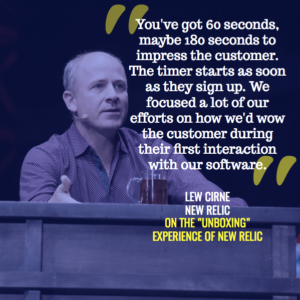
You’ve got 60 seconds, maybe 180 seconds to impress me. The timer starts as soon as you sign up. How do we wow the customer then? That was super important, and then I feel like it’s part of the success.
Jason: How are you since we went back to the early days? You see the iPhone. You have the Wily experience. You want to have an amazing user experience from day one. You want to bring the iPhone to the enterprise which I think say we all get, but back then it was a little bit innovative.
Lew: Thanks to your publications we know all understand the process.
Jason: We all get it. How did you get it? You were a second-time founder… How did you get New Relic really going? How did you get the first 100 customers or 200? What was the hack that got it off the ground?
Lew: It was…not having the benefit of the collective wisdom that’s in this room today. This was mostly landed on learning from my first one as I said. How we got the thing going was how lots of companies get started. I started this with a prototype. New Relic started as my “teach myself Ruby on Rails project”. I still love…
[crosstalk]
Jason: I remember reading that.
Lew: I learned this language Ruby and one of things about Ruby is interesting is how easily hackable the code is. There’s part of me that says, “Wow, I could build the equivalent of the Wily Agent, a far better one, far faster.”
Jason: That’s a classic Ruby story.
Lew: That was my little teach myself Ruby project. I was looking for things to do on my sabbatical. I showed up here like, “Wow! We could really use this.” I was like, “Wow. Maybe I’ll do the Basecamp thing and self-fund a little lifestyle business.”
Not to in anyway, disparage that. A great lifestyle business, but the idea was just how far can I go with this little idea? It turns that it had the potential to be much larger and it made sense to attract venture funding.
I found a way to connect with thought leaders in the Rails community. One of the things that I think is super important is early on taking the right size of market segment to focus on so you can own it. Ruby on Rails for performance marketing.
Certainly, it wasn’t market size that attracted Benchmark to that deal because it’s a great market, but it’s not a large market… but we could own it. The way we owned it was to reach out to the thought leaders in that community and we got them to try it.
On the day we launched, we had references from the likes of Basecamp, 37signals at the time, and a few other Rails core committers. We had a partnership with a big Rails hosting company at the time that brought our product to 400 customers day one.
Jason: Got it.
Lew: You got to be thoughtful to how you launch. It can’t just be product.
Jason: Hyper-focused on Ruby on Rails and direct outreach to enough folks to get those first 10, 100 customers, right?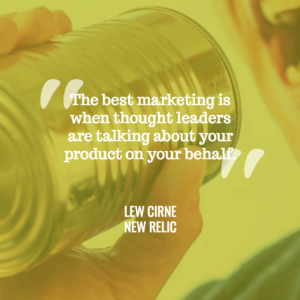
Lew: Get those thought leaders and Twitter was in its infancy, but all those people who were on Twitter. You got this wonderful… you know, that’s marketing of course is when thought leaders are talking about your product on your behalf.
Jason: Did you know to go for it and do a non-lifestyle business at that point or when was it after that? When was that moment when you allowed Benchmark to invest?
Lew: Peter Fenton at Benchmark. He’s a dear friend. I was his first venture deal in 2001. We go way back. He has a remarkable…
Lew: [laughs] He has a remarkable wine collection and I remember having a spectacular glass of wine in 2008 where we thought about whether we should work together again. He said, “If we’re going to do this, let’s build a great company together with no regrets.”
Obviously, that implies being big and having an impact and growth and revenues and all that, but somewhere we loved the journey and there’s nothing we’d rather do and be engaged in this business. He’s remarkably persuasive. And it was true.
That was what we decided to try to do. It’s fueled how I thought about New Relic along the way is let’s never regret a Monday doing this thing. That drives why we like to deliver our product to more customers, to more end users, and deliver more amazing products that do the bulk of the selling.
I know this is probably part of what you want to talk about, but what’s the role of product versus sales professional in the process is super important to think about when you build your business.
Jason: Let’s dig in there for a minute since you brought it up. New Relic launches, it’s a freemium product. It’s going to be huge, but it’s freemium. We’d all love…
Lew: The jury was out on how huge was going to be.
Jason: What’s that?
Lew: The jury was definitely out early days.
Jason: We all hoped that freemium would scale infinitely back in the day, ’07, ’06. It seemed like freemium was this magic and sometimes it is. What were the learnings? Where did you see…was it just going upmarket or did you see a ceiling to that early or what were…?
[crosstalk]
Lew: We learned a lot. You learn a lot by just engaging in the market. The first time we launched in June of ’08, no free tier. We had those first three or four hundred customers through a partnership and then they were trickling in one or two at a time thereafter because we just thought the product would just attract customers and that’s surprising for a second-time founder.
It’s like how far can we push this with the leanest…
Jason: What did New Relic cost then if you bought it off the website?
Lew: Surprisingly, it’s similar to today. I think at that point, we had eight to a hundred dollars a server or a host I think was the price point back then, but it was a much lesser functionality. We hadn’t developed some killer features that we knew the market would value.
We were moving really fast. We had another major launch three months later where we had all these new features that could differentiate the tiers go at $200 a month per server. I remember my Chief Product Officer and me just saying, “What should we do about free?” We decided to go for it and try it. That had immense impact on our top line.
When we launched the higher end product, we also launched lite in September of ’08. The chart had one of its first, these are all bursties, but it had a nice period of time where sales really started to come in, driven off the awareness that lite brought to the market.
Jason: When did you come to conclusion that having adding salespeople would accelerate that versus take away from it? It’s something we all struggle within the more developer- or product-focused you are, the more sometimes folks wrestle with this question.
Lew: It is. That’s a great question. I feel the history of the company has been how far can you take it? Take it to the extreme to see how far you can go with a certain thing, learn from it, and then feather in things that can help accelerate your business that come with a structural operating cost like sales. I’ll talk about support as another example.
We went throughout all of 2008 without a sales rep. We got pretty far. Again, Peter Fenton, and I think he was the only board member in most of 2008, he said, “Who actually talks to your customers?” I’m like, “Geez.”
That’s a pretty good question that I should have the answer to because we didn’t have someone full-time talking to customers.
Jason: Even just on success. What we call customer success.
Lew: We had people answer the phone, but nobody really fully tasked with having very small Lean Series A company. We decided to experiment with, “What would happen if we had someone calling out to prospects, calling out to free trials and things like that, and trying to convert them?” Lo and behold, they converted better.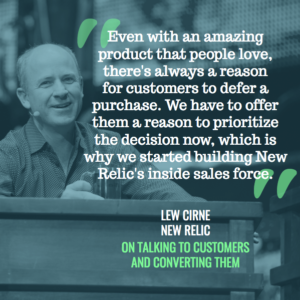
It turns out that even with an amazing product that people love, our customers are super busy and there’s always a reason for them to defer that purchase, their subscription decision to next week. We have to offer our customers a reason to prioritize the decision now and it had an immense impact on sales. We started to build out that inside sales force starting 2009.
Jason: Just for fun because we had Jay before, to put words in his mouth which might be the wrong words, I’m going to say, “That’s great, Lew. You put the salespeople. You pulled the revenue forward, but so what? You get the customer anyway and I’m going to get them for 10 years, so it doesn’t matter.”
What you learn is if you pull it forward, you close more of the customers.
Lew: That’s been our experience. It really varies by product and market. Atlassian is a remarkable story of how they’ve been able to do it without the sales function.
In our case, we wanted a model that was affordable for smaller companies but scaled very nicely with large companies. We do have a very nice tiered customer base where we’ve got well over 25 percent of the Fortune 100 and many multi-million dollar a year subscribers. We also have an awful lot of $200, $100/month customers.
The sales function was essential to driving people into those higher tiers. What I liked about the New Relic model, apart from the previous one, is you could get started at a reasonable price point because the product was so self-explanatory and easier to use compared to the others in our space.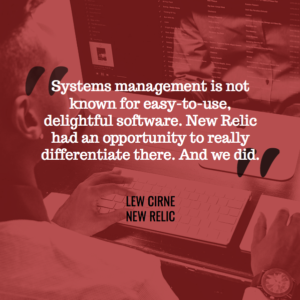
Believe me, systems management is not known for easy to use delightful software. We had an opportunity to really differentiate there. And we did.
The sales team was really about getting people who already tried and liked our product make a commitment to be a customer and then grow them as customers.
Jason: New Relic, I would describe it as a relatively sales efficient certainly compared to a lot of companies out there. How did think about that? Did you manage to do any of these goals in terms of CAC and magic numbers and ratio?
Did you say, “We’ll spend this much on sales but we don’t want to impact the bottom line too much?” Is there a way you hacked or backed into that because I’d say New Relic is this middle path between blowing it all on the team and spending none?
Lew: We never thought of ourselves a growth at all cost company.
Jason: Sorry, say that again.
Lew: Growth at all cost company.
Jason: Growth at all cost company.
Lew: I feel like there were several of those in prominent places two years ago. The tide is turning a bit on sentiment around that.
My CFO, Mark, and I have worked together since ’99. Two companies now. We always wanted to have good control over the business. We raised money after 9/11. We raised money on the crash of 2008. We’ve seen it all. This is a walk in a park.
Jason: You’re blood brothers or something like that.
Lew: This is just so easy compared to what we’ve seen going on right now. We always wanted a complete control on business. That’s why we landed on the SaaS model. We wanted very predictable revenues. We didn’t want to be holed into one or two customers. At New Relic, no customer’s more than two percent of our subscription base.
There’s a variety of ways we did CAC, LTV and things like that. One of our gut checks was always periodically, I’d check with Mark and say, “If we froze hiring today, how many days until cash flow?” Even in Series A, Series B timeframe.
What if the market fell apart today and there were just no sources of funding? Would we have to have layoffs?
Jason: Only those that have to live through those moments in time do that exercise. [laughs]
Lew: It was always 90 days or less. We could freeze hiring, keep the investor where he’s at. Within 90 days…
Jason: There’s enough growth you’d catch up to it.
Lew: There are various ways we do it today. It’s a little different. We’re in a different level of scale. Now, we just generated our first cash deposit quarter last week. It’s always been a business we’ve had under control. A big knob in that is sales and marketing investment, obviously. It’s by design.
Jason: Tell me a little bit because I want to learn about it, talk about the journey as you go from something that’s still very much an engineering and developer focused product but consumed by more and more people in the company and the enterprise.
A lot of that is not obvious. Some people overstate that happens. How many of your customers are CMOs directly? You have a much larger footprint in the companies. What are the learnings and what happens here over time?
Lew: This has certainly been a journey that I started back in Wily where I remember in 2002 or ’03, we’re like, “All right. We have this age in observing everything in software.”
And just think what goes on in software, every time you deposit a check, that falls into your software. Every time you purchase something online, that falls into your software. That data has to be valuable to more than just the people that debug the software.
This has been a problem I’ve noodled on for well over a decade. The developer community, they create massive market technology standards. The developer community created standardizations that are AWS and MySQL and Linux. It wasn’t a top down CIO dictum that says, “We’re standardizing on Linux in ’99.”
Jason: That’s for sure.
Lew: An army of grassroots developers that find something that’s better and then inevitably work their way into the enterprise. We want them as a key constituent. They’re a hard crowd to please. If you please them, your competitors are going to struggle to try to migrate over there.
There’s the IT ops team. They’re a super important constituent to us as well because if you’re going to standardize across a large enterprise, central IT has to be super involved and they’re often driving that decision.
Whereas New Relic a couple of years ago was doing great on digital and departmental deals and showing success in the modern customer facing projects that are driving the top line, now we’re standardizing. We just announced last week. We’re global standard at General Electric now. That involves engagement with IT.
Jason: They’re looking for something different out of New Relic.
Lew: They have their own requirements.
Jason: They don’t really care about user interface or whether you can deploy in 15 minutes.
Lew: They spend a lot of time for a crappy software. We’re going to liberate them from that tyranny. They do have their own requirements. They have manageability. They care about making sure the right people have access to the right data. There’s a long list of things that they care about and we have made those a priority.
The third constituent to your question is the business folks, the digital business leaders that want to see, “How many widgets am I selling on my e-commerce site?”
Jason: They’re stakeholders clearly in New Relic today. They’re stakeholders.
Lew: Our vision is, we’re the first best place to look to understand your digital business, whether you’re developer, operations or a digital business leader. All coming from the New Relic platform. That’s a big opportunity.
Jason: It’s huge. How do you market that? How do you communicate that message versus the message from three to four years ago?
Lew: Well, it’s this conference. That’s all I need to do. It’s done. [laughs]
Really, we think about again, how does New Relic get discovered at an organic level? How do people search for New Relic more? Rather than us blasting New Relic through the traditional marketing channels.
It starts with an amazing product that people tell their friends about. It starts about communities of people that self-reference and then that gets us into an account typically, then what’s the marketing and messaging plan once you’re in the account?
Typically account acquisition happens through the developer or the innovation engine in an enterprise that wants great stuff that works well that’s fast and that’s easy to use and modern. Then, how do we message that to grow within that account is a nuance of how we go to market. You do need a slightly different message for different constituents and they all are important.
Jason: CIO’s and GE’s looking for different things.
Lew: They are. What’s exciting to me is GE has publicly declared themselves a software company with those cool commercials about how GE is a software company. If you’re transforming and this is happening across the world, companies are becoming software companies.
They realize, the old vendors, especially in the systems management space, don’t understand that motion. They don’t understand Agile. They don’t understand fast iteration, customer…
Jason: They don’t understand it or they just don’t want it? Or they can’t or they don’t want to change.
Lew: I don’t think they have a culture of delivering on it.
Jason: I don’t think anyone’s stupid out there usually, it has a real…
Lew: No, no, no, that’s fair to say. Maybe they understand the concepts but they have decades of operating a different way by…
Jason: Yeah, they’re not going to change.
Lew: It’s baked in their financial model, their compensation model. Their product engineering discipline across the company. That’s why we think we’ve got an opportunity.
Jason: On a related note, how have your views and what are your Zen learnings on competition through the different phases of New Relic or even before? Because you’re in a competitive space. But I think in a segment of a very competitive space, you have a fairly strong market presence but not in every segment.
How does that change over time as you even just get bigger? You have large numbers to start thinking about.
Lew: Sure. It has changed over time. Early on, we had very little or no competition in APM and SMB and that created…I’m from Canada and I felt like our company became just this nice Canadian company that everyone liked to work with and then all of a sudden, as we grew, more and more folks coming up saying…we’re going to go straight at New Relic.
We’re going to out New Relic, New Relic. Then, of course, as we move into these large IT budgets, there’s a bunch of people saying, “That’s my turf.” They’re going to get defensive about it and get really aggressive on us and so, we’ve had to learn to be a little less Canadian, culturally.
Someone punches you three times in the face in the schoolyard, you’ve got to at least defend yourself and maybe punch back.
Jason: I feel like kumbaya ends around 10 million in revenue.
Lew: Yeah. We have gone through that change over the last three to six months, to be candid with you, culturally. It’s great. It helps us mature as a company. We can’t lose sight of the fact that our mission is to deliver on that vision I just described and to do it for…we do it for hundreds of thousands of users today.
There are obstacles to achieving that mission and those obstacles involve, we think, competitors with products that have a poor user experience, harder to manage, harder to use and really do our customers a disservice, so it’s in their interest for them to see the light that is New Relic.
Jason: In terms of raising tons of capital and competition, we sometimes wonder what’s going on in the market sometimes. New Relic, I think, is a medium…You raised, by 2015 standards, relatively small rounds, maybe a third and the IPO, something like that.
When your competitor raises 100 million or 80 million or 190 million, what’s your advice to grok that and think about it? Because it is real money, right? It enables folks to do things that aren’t particularly profitable. You’re in kumbaya land. I love Canada. Why can’t we all be friends?
Then you wake up and you read TechCrunch and they raised 100 million. What’s your advice or Zen learnings there?
Lew: First of all, let me take you on a little history of the funding of the company. Our series A was 3, 3.5 million dollars. Our series B was six million dollars. We raised small rounds by design because small rounds early on are a forcing function to help you really think hard about your model and the scalability of your company and to be wise with your investment dollars.
Focus is so important early on.
Jason: You clearly could have raise much more after Wily. You could have raise as much as you wanted.
Lew: Yeah, we had offers to raise a lot more money and we felt like there are times when you need capital to solve problems and there are times when you need really smart thinking to solve problems on a smaller scale and especially early on, I feel like companies overcapitalize.
We didn’t want to do that. I think a lot of our competitors did. You can manufacture growth with spending. Certainly we invest for growth but as I say, we’re not growth at all costs. Early on, when we felt like we had a really solid model, like, for example, last quarter we announced a net expansion rate of 129 percent.
That means that if we don’t add another customer to the company today, net of churn, our business will grow 29 percent over the next year.
Jason: Helps with the nuclear winter strategy too.
Lew: It certainly does. That’s part of the model we’ve built. If you think about how you structure that, capital…I love exactly where we are in this competitive market and this challenging public market situation because I feel like over capitalized competitors have a lot of hard work to do to figure out how they’re going to rationalize their businesses in this kind of market.
I don’t think we have that problem.
Jason: I agree. In a competitive landscape, there’s two ways to take advantage at being overcapitalized. One is just throw money at growth, which, assuming you have an engine, sort of works. You can have a bad CAC but you can force yourself in.
The other thing you can do with a lot of money is you can play dominant-dominant strategy. You can say, “You know what? I can’t really compete in New Relic space profitably. I’m going to lose but I’m going to do it anyway.
I’m going to put 10 million and I’ll never make money competing with New Relic and I don’t care because I can play dominant-dominant and that is confusing for founders. Dominant-dominant.
Lew: That’s why I say this is a wonderful time because that might have worked two years ago when multiples were through the roof.
Jason: Yeah, that’s what an advantage is. Play dominant-dominant.
Lew: You’re not going to be able to fund a money-losing company with that strategy in today’s investor environment, nor should you. Again, if you’ve got the time frame we have, the time horizon we have in our decision making, focus on building awesome stuff that our customers love, those will be temporary distractions.
Jason: For sure. Let’s talk a little bit about, as you get bigger, how the product grows. With Jay at Atlassian, we’re talking about four products, which to me, still boggles my mind. It’s a lot to manage. I think you’ve still got one-ish product but really a family underneath one-ish product.
I don’t even know what the acronym today is. New Relic isn’t APM anymore, right?
Lew: Software analytics.
Jason: What is it? Sorry.
Lew: Software analytics.
Jason: Software analytics. That works too.
Lewis: It certainly does.
Jason: Just do your series A again, just on that. What are your learnings? How long do you stay focused? Do you let the market pull you? You didn’t like that experience at Wily, but not every…
[crosstalk]
Lew: This is a wonderful opportunity to clarify something. We have five SKUs all organically built. They all work flawlessly together. You may think of it as looking like one product because it’s such a seamless, integrated experience which, again is just unheard of in the systems management space.
Historically, these companies have built their product portfolios through acquisition and they’ve never worked well together. We’ve done the opposite. Half our business comes from multi-product customers. What have we said publicly? We’ve said things like, I think…
I’m going to get myself into trouble with what we said publicly, but…
Jason: Let’s do rough and tough.
Lew: Well north of 20 percent of bookings we’ve seen a given quarter being non-APM. This is part of our strategy is this platform. APM monitors the healthy application running on the server. If you want to see what’s going on in the mobile device, that’s a separate problem.
You want to see what’s going on in the browser. You want to do synthetics, if you remember, like the mercury business back in the day. We have New Relic synthetics, which allows people to actively monitor their application.
Then, of course, New Relic insights, which opens up this whole analytics opportunity servicing the various needs of the business user. We now do five-product deals routinely and customers are buying us in on the solution.
That’s a big part of our competitor strategy is that it’s not a kitchen sink strategy. It’s that these things belong together and the whole problem needs to be solved. But that it can’t be done by rolling up disparate products that don’t really work together.
That’s where I think having R&D-centered culture and I’d describe New Relic as a product-first company, that works to our advantage over the long term.
Jason: As the product does, as you have the five SKUs, do you let the market pull you there because it still is distracting, each SKU is distracting and we’d all love in a perfect world to do one product, have no competition, and it’s just social network…
Lew: I wouldn’t.
Jason: You wouldn’t like that.
Lew: I love building products.
Jason: No, no, we’d have to keep building products but building 50 is a lot harder than building 5.
Lew: No, I don’t want 50. I want…Some products need…
Jason: How far…?
Lew: There’s a bit of the market pulling and then, of course, there’s the whole…What’s beautiful about the technology industry is sometimes there’s this harebrained, crazy idea where you try to define where the market will go. Wily was that and then New Relic was that for democratizing that category software.
Now, APM being something that’s a little long in the tooth now as a 17-year-old category, software analytics was about servicing the needs of the business user.
There is a bit of that innovation that you can’t find in a customer meeting or in a Gartner report or an IUC report but then there has to be also a healthy balance of just, let’s see your customers, asking them what their problems are and solve them for them.
A key part of what I think of product strategy is, it obviously has to be something that we believe makes business sense. We can sell it and we can offer it to probably the same buyer or similar buyer but it also has to have this unnatural advantage of leveraging what we already offer to the customer.
We can’t just build it in isolation of what the market wants. We also think of, what are our unique skills and strengths that make what we can offer so differentiated that, again, it comes back to that whole, the way you described New Relic at the beginning.
We generally have a really good brand with our customers to building stuff that pops, that people like to use and that has to be part of why we decide to build something.
Jason: One of my things I like to do, but to a fault, is over simplify things, to make it simple. I try to have a rule that 25 percent of development time was focused on stuff that I know we need to build, but I don’t have customer demand, today, for. Going into that category of the future that you can see, but you don’t have demand today, did you budget it? At this scale, how do you think about that?
Lew: It was the McKinsey report that defined it in horizon one, horizon two, horizon three. I’m not sure.
Jason: I got to read that one.
Lew: The notion is your horizon one product is your established product that has been paying the bills, and is the flagship of the business today. Horizon two is the newer stuff that’s in the market, that’s growing faster. Horizon three is almost speculative.
Jason: Right, horizon three. How much time should we spend there?
Lew: In a way, it’s reminiscent of my comment on capital. You don’t need a lot of capital on horizon three, but you need to put really smart, or really capable builders, and innovators…There’s a different skill set, comfort with uncertainty, and ability to face the fear that what you’re building may suck, or may have no value, and things like that. I face that fear continually when I create things.
Jason: They can’t lose their job if…
Lew: The whole “coding CEO” thing is bit of my persona, but I wouldn’t want it to be interpreted that that’s the innovation engine of the company in and of itself. I do it as therapeutic thing for me. It helps me think, and energizes me for coming back to the company, and connects me with what we’re building today, and what the needs of our customers are, and sometimes I come out with ideas that actually help on horizon three.
We have a horizon three team. It’s a small team. The trick though is, I think Jay spoke to this a bit, you got to think about when you’re building products, also, who are the people that you have, and can they build amazing things?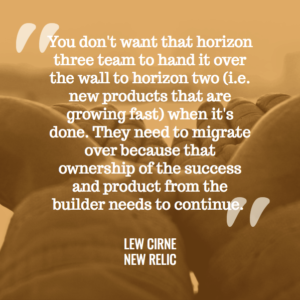
You don’t want that horizon three team to hand it over the wall to horizon two when it’s done. They need to migrate over because that ownership of the success, the product, from the builder, that product needs to continue.
Jason: You need to let horizon three folks own it as it becomes horizon two is the learning?
Lew: Yeah. At least one or two engineering leaders that are kind of, in a way, they’re the founder of that idea. Great products come when there feels like there’s this ownership that this is your baby, and that you want it to succeed. In the case of New Relic Insights, that was, for me, the idea hit me for the insights database technology, December 29th, 2012.
I was in Tahoe with my family. My wife knows that when I get that idea I get a little crazy, but sometimes great things happen for the company, so she packed up my daughter, and they went back home. Then I coded for 10 days in Tahoe, and I came out with a database, or at least the beginnings of a database.
I stayed through with it for through the first six months of the year. I had a very strong president, someone who in some ways reminds me of Jay. I said, “Look, I’m going to be less present for a lot of the horizon two, horizon one, running the business, sales. That’s all important stuff, and I’m not going to disengage entirely, but for the next six months, I want to make sure this thing becomes a product.”
“And so I’m going to build the team around it. I’m going to cordon them off from the whole keeping the company running, so that it has enough focus, and momentum to make it through the market.” That’s how it came out.
Jason: Just on a related, especially for founders here that don’t have an engineering background, we’ll all end up getting at least, even early, at least one or two just insane, great engineers that are hackers, that can go out and build you something in a week, or a day that would take anyone else 90 days, and the whole PRD to build, and they build amazing stuff for you. Is your advice to try and get them then to own the product as you truly put it into true production?
Do you think that person can own it to the CIO of GE? You have more experience than me, but I found that a struggle to have her continue to own it as the product gets handed off to GE level.
Lew: It needs to get to a certain level where it’s probably past the first GA. The great art, and difficult part about managing builders of software, engineers in particular, is somehow trying to align where the company wants to go with what they desperately want to build, and they’re rarely in perfect alignment.
The last thing you want to do is tell them, “Don’t do this thing you’re very passionate about. Never do that. Do what I want you to build.” Right? [laughs] They’ll leave the company, or they’ll grudgingly build something that doesn’t wow the customer.
Jason: That’s all excellent points.
Lew: You somehow need to attract them over to where you think the company needs their creative juices, and challenge them with, “I wonder if it’s going to be possible to solve this hard problem. I don’t think you…You think you could do that? Really? Why don’t you give it a try?” and then all of a sudden they come away with something magic.
Jason: This is one of the most important skills to learn as a CEO, if you haven’t done it, is how to make your best people do that, but it’s not easy.
Lew: But it’s fun.
Jason: You’re better at it than me, but it is fun. Especially when the big customer asks for something that was already on your road map, but not for this week, and we have to build it tomorrow, and it’s boring, and it’s a lot of work.
Lew: What if it’s better than what the customer even imagined? That’s when magic really happens.
Jason: That’s the magic. Before we run out of time, I want to go back to the comment you made earlier about Peter Fenton telling you to talk to customers. Let’s fast forward today, and let’s tie that into that 129 percent net negative churn number, which is magic. It’s the magic to all of this.
Lew: At our scale.
Jason: How much time do you spend with customers now, and how has that changed over time?
Lew: I have a customer call this afternoon. I budget about three to six full days per quarter for that now.
Jason: Three to six days a quarter?
Lewis: Yeah. Around that. I have a budget for investors so many days per quarter.
Jason: Who gives you the quota? Is it a self quota, or does your chief revenue officer do it?
Lew: Every December, my New Year’s resolution ritual is how am I going to divide my time for the rest of the year, and align it with the needs of the company?
Jason: Three to six days with customers.
Lew: That’s where I’m at today. That’ll change depending upon the needs of the company.
Jason: Do you get pulled into more deals, now that you have bigger deals? You do probably have to talk to…
Lew: Erica’s going to be here, our head of enterprise.
Jason: We’ll have her talk about it this afternoon.
Lew: She probably thinks not enough.
Jason: Not enough, yeah.
Lew: But we want to be strategic with it.
Jason: Do you spend more time with customers than you did three or four years ago, as you’ve gone through…?
Lew: It’s going through ups and downs. I’ll say a little bit more.
Jason: A little bit more, yeah.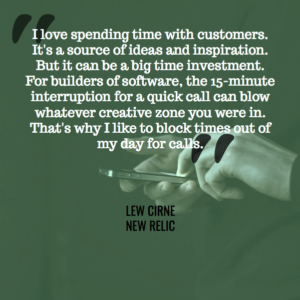
Lew: I love spending time with customers. It’s wonderful. It’s a source of ideas and inspiration. It can be a big time investment, especially if there’s travel involved. I feel like, for those of you who are builders of software in the audience, the 15-minute interruption for that one quick call can blow whatever creative zone you were in.
Jason: It’s half a day. You lose half a day.
Lew: That’s why I like to block times, where they’re just sacrosanct, so that maybe good creative things come out of it.
Jason: Let me ask a related question, and maybe Erica owns both, so we can find out this afternoon. Is that three to six days include existing customers and prospects, or is it just existing customers, and how do you balance your time?
Lew: Usually both. A large portion of our business comes from upselling existing customers.
Jason: Today, with 129 percent, what’s a better use of your time? Spending time with existing customers, and making sure you kill it, or landing the next GE? What’s a better use of your time today?
Lew: It’s not a good use of my time to bring me in to close a deal. It is a good use of my time to align with leaders within customers and prospects, to get them excited about the New Relic vision, and to make sure that they feel like they’re partnering with the right company.
We’re trying to build a very high quality that goes for a long period of time. When you’re a GE, you’re not looking for the feature today. You’re looking for partner, hopefully that goes for a very long period of time, and I’m delighted to have those kinds of conversations.
Jason: You need to meet with GE today as much as ever, don’t you? Challenge me if I’m wrong. Help educate me. New Relic is a big company compared to a lot of peers here, but compared to GE it’s a little tiny company.
Lew: Part of scaling, as the leader, is it can’t fall all on your shoulders. Our president, Hilary Caldwell McAdams, is incredibly gifted, and talented, and she was President of Sales of SalesForce.
Jason: You get a lot of scale?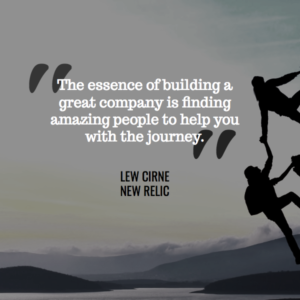
Lew: Her Rolodex is better than mine.
Jason: You get scale there, is the key, right?
Lew: We got scale. I get brought in when it’s about product and vision, and technology strategy, and values of the company, and then Hilary can do just fine speaking to any CIO.
Jason: That’s magic in scaling that she can do that for you. Not everybody has that asset all the time.
Lew: That’s the essence of building a great company, is finding amazing people to help you with the journey.
Jason: That’s for sure. All right, Lew. This was amazing. Thank you very much.
Lew: Thank you.
Jason: This was great.
Lewis: All right. Thank you.
Jason: Thank you very much.
[applause]
Lew: Thank you all.
